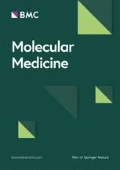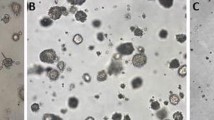Abstract
Human fibroblasts immortalized by Simian Virus 40 (SV40) are widely employed for cell and molecular biology model of study. Indeed, SV40 transmission to humans was believed to occur only under exceptional situations. The oncogenic potential of SV40 in laboratory animals is well established, whereas its involvement in human carcinogenesis is still a matter of active investigations. A recent report links SV40 exposure with the development of a brain tumor in a laboratory researcher. In previous studies, episomal viral DNA was detected in SV40 stably transformed and immortalized fibroblast cell lines. In this study, we report molecular and biological characterizations of SV40 DNA in human fibroblast cells. Our results indicate that SV40 is able to establish a persistent infection in long-term immortalized human fibroblasts, resulting in the production of an infectious viral progeny, which is able to infect both monkey and human cells. These data indicate that SV40-immortalized human fibroblasts may represent a source of SV40 infection. To avoid the SV40 infection, careful attention should be given by operators to this SV40-cell model of study.


Similar content being viewed by others
References
Arlington AS, Moore MS, Butel JS. (2004) SV40-positive brain tumor in scientist with risk of laboratory exposure to the virus. Oncogene 23:2231–5.
Barbanti-Brodano G et al. (2004) Simian virus 40 infection in humans and association with human diseases: results and hypotheses. Virology 318:1–9.
Shah K, Nathanson N. (1976) Human exposure to SV40: review and comment. Am. J. Epidemiol. 103:1–12.
Carbone M et al. (1997) Simian virus-40 large-T antigen binds p53 in human mesotheliomas. Nat. Med. 3:908–12.
Ferber D. (2002) Virology. Monkey virus link to cancer grows stronger. Science 296:1012–5.
Strickler HD et al. (1998) Contamination of poliovirus vaccines with simian virus 40 (1955–1963) and subsequent cancer rates. JAMA 279:292–5.
Li RM, Branton MH, Tanawattanacharoen S, Falk RA, Jennette JC, Kopp JB. (2002) Molecular identification of SV40 infection in human subjects and possible association with kidney disease. J. Am. Soc. Nephrol. 13:2320–30.
Butel JS, Lednicky JA. (1999) Cell and molecular biology of simian virus 40: implications for human infections and disease. J. Natl. Cancer Inst. 91:119–34.
Barbanti-Brodano G et al. (1998) BK and JC human polyomaviruses and simian virus 40: natural history of infection in humans, experimental oncogenicity, and association with human tumors. Adv. Virus Res. 50:69–99.
Jasani B et al. (2001) Association of SV40 with human tumours. Semin. Cancer Biol. 11:49–61.
Garcea RL, Imperiale MJ. (2003) Simian virus 40 infection of humans. J. Virol. 77:5039–45.
Jafar S, Rodriguez-Barradas M, Graham DY, Butel JS. (1998) Serological evidence of SV40 infections in HIV-infected and HIV-negative adults. J. Med. Virol. 54:276–84.
Basetse HR, Lecatsas G, Gerber LJ. (2002) An investigation of the occurrence of SV40 antibodies in South Africa. S. Afr. Med. J. 92:825–8.
Bright RK, Kimchi ET, Shearer MH, Kennedy RC, Pass HI. (2002) SV40 Tagspecific cytotoxic T lymphocytes generated from the peripheral blood of malignant pleural mesothelioma patients. Cancer Immunol. Immunother. 50:682–90.
O’Neill FJ, Carney H, Hu Y. (1998) Host range analysis of simian virus 40, BK virus and chimeric SV40/BKV: relative expression of large T-antigen and Vp1 in infected and transformed cells. Dev. Biol. Stand. 94:191–205.
O’Neill FJ, Carroll D. (1981) Amplification of papovavirus defectives during serial low multiplicity infections. Virology 112:800–3.
Bocchetta M et al. (2000) Human mesothelial cells are unusually susceptible to simian virus 40-mediated transformation and asbestos cocarcinogenicity. Proc. Natl. Acad. Sci. U.S.A. 97:10214–9.
Cacciotti P et al. (2001) SV40 replication in human mesothelial cells induces HGF/Met receptor activation: a model for viral-related carcinogenesis of human malignant mesothelioma. Proc. Natl. Acad. Sci. U.S.A. 98:12032–7.
Shay JW, Wright WE. (1989) Quantitation of the frequency of immortalization of normal human diploid fibroblasts by SV40 large T-antigen. Exp. Cell Res. 184:109–18.
Huschtscha LI, Holliday R. (1983) Limited and unlimited growth of SV40-transformed cells from human diploid MRC-5 fibroblasts. J. Cell Sci. 63:77–99.
Hara H, Kaji H. (1987) Random integration of SV40 in SV40-transformed, immortalized human fibroblasts. Exp. Cell Res. 168:531–8.
Huang KC, Yamasaki EF, Snapka RM. (1999) Maintenance of episomal SV40 genomes in GM637 human fibroblasts. Virology 262:457–69.
Forsman ZH et al. (2004) Phylogenetic analysis of polyomavirus simian virus 40 from monkeys and humans reveals genetic variation. J. Virol. 78:9306–16.
Morelli C, Barbisan F, Iaccheri L, Tognon M. (2004) Simian virus 40 persistent infection in long-term immortalized human fibroblast cell lines. J. Neurovirol. 10:250–4.
Barbanti-Brodano G et al. (2004) Reactivation of infectious simian virus 40 from normal human tissues. J. Neurovirol. 10:199–205.
Martini F et al. (2002) Different simian virus 40 genomic regions and sequences homologous with SV40 large T antigen in DNA of human brain and bone tumors and of leukocytes from blood donors. Cancer 94:1037–48.
Clever J, Yamada M, Kasamatsu H. (1991) Import of simian virus 40 virions through nuclear pore complexes. Proc. Natl. Acad. Sci. U.S.A. 88:7333–7.
Martini F et al. (1996) SV40 early region and large T antigen in human brain tumors, peripheral blood cells, and sperm fluids from healthy individuals. Cancer Res. 56:4820–5.
Carbone M, Rizzo P, Pass HI. (1997) Simian virus 40, poliovaccines and human tumors: a review of recent developments. Oncogene 15:1877–88.
Vastag B. (2002) Sewage yields clues to SV40 transmission. JAMA 288:1337–8.
Sainis L, Angelidis C, Pagoulatos GN, Lazaridis L. (2000) HSC70 interactions with SV40 viral proteins differ between permissive and nonpermissive mammalian cells. Cell Stress Chaperones 5:132–8.
Klawitz I, Preuss U, Scheidtmann KH. (2001) Interaction of SV40 large T antigen with components of the nucleo/cytoskeleton. Int. J. Oncol. 19:1325–32.
Li PP, Nakanishi A, Clark SW, Kasamatsu H. (2002) Formation of transitory intrachain and interchain disulfide bonds accompanies the folding and oligomerization of simian virus 40 Vp1 in the cytoplasm. Proc. Natl. Acad. Sci. U.S.A. 99:1353–8.
Nakanishi A, Shum D, Morioka H, Otsuka E, Kasamatsu H. (2002) Interaction of the Vp3 nuclear localization signal with the importin alpha 2/beta heterodimer directs nuclear entry of infecting simian virus 40. J. Virol. 76:9368–77.
Pelkmans L, Puntener D, Helenius A. (2002) Local actin polymerization and dynamin recruitment in SV40-induced internalization of caveolae. Science 296:535–9.
Gordon-Shaag A, Ben-Nun-Shaul O, Roitman V, Yosef Y, Oppenheim A. (2002) Cellular transcription factor Sp1 recruits simian virus 40 capsid proteins to the viral packaging signal, ses. J. Virol. 76:5915–24.
Milavetz BI. (2002) SP1 and AP-1 elements direct chromatin remodeling in SV40 chromosomes during the first 6 hours of infection. Virology 294:170–9.
Cripe TP, Delos SE, Estes PA, Garcea RL. (1995) In vivo and in vitro association of hsc70 with polyomavirus capsid proteins. J. Virol. 69:7807–13.
Chromy LR, Pipas JM, Garcea RL. (2003) Chaperone-mediated in vitro assembly of polyomavirus capsids. Proc. Natl. Acad. Sci. U.S.A. 100:10477–82.
Lednicky JA, Butel JS. (2001) Simian virus 40 regulatory region structural diversity and the association of viral archetypal regulatory regions with human brain tumors. Semin Cancer Biol 11:39–47.
Acknowledgments
This study was granted by Associazione Italiana per la Ricerca sul Cancro and M.I.U.R. Cofin and local projects. Laura Iaccheri was supported by a fellowship from the Fondazione Cassa di Risparmio di Cento.
Author information
Authors and Affiliations
Corresponding author
Rights and permissions
About this article
Cite this article
Morelli, C., Barbisan, F., Iaccheri, L. et al. SV40-Immortalized Human Fibroblasts as a Source of SV40 Infectious Virions. Mol Med 10, 112–116 (2004). https://doi.org/10.2119/2004-00037.Morelli
Received:
Accepted:
Published:
Issue Date:
DOI: https://doi.org/10.2119/2004-00037.Morelli




